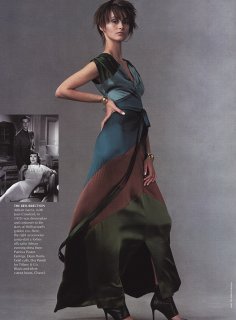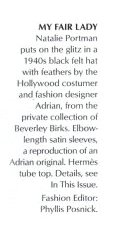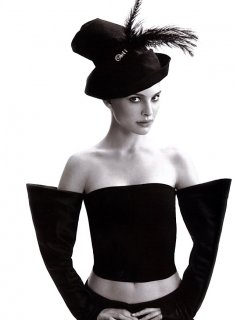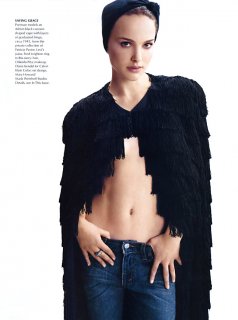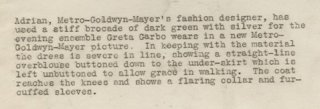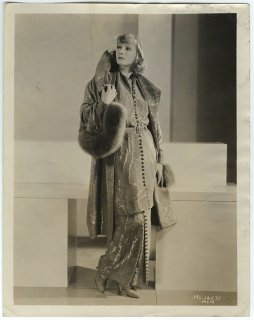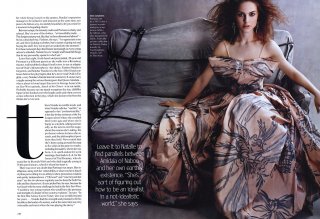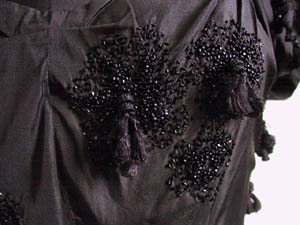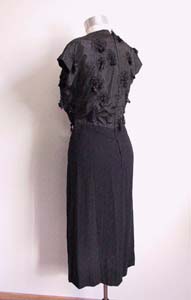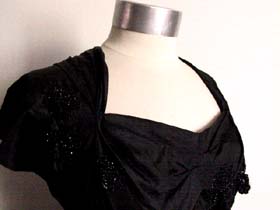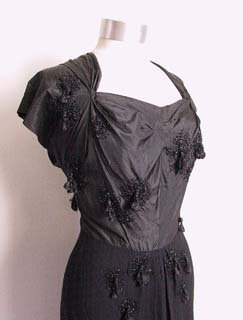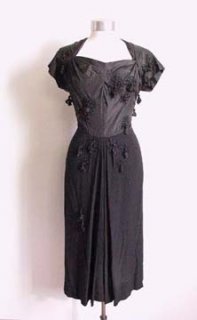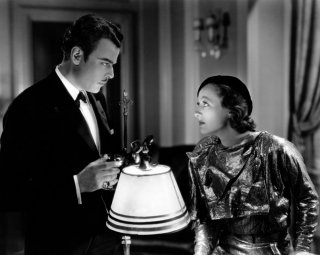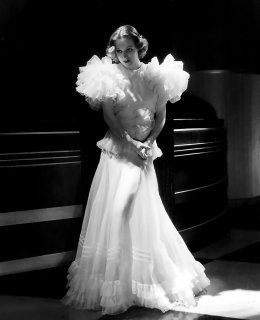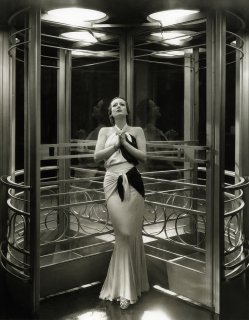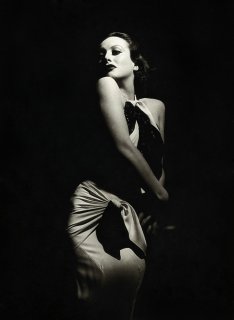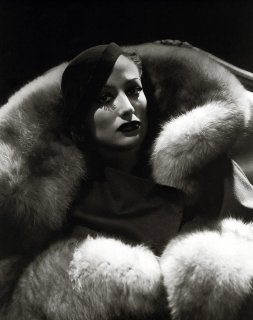Sunday, March 13, 2005
Glamour: Fashion, Film, Fantasy / The Museum at FIT, NYC / February 15 - April 16, 2005
Camille; directed by George Cukor; starring Greta Garbo, Robert Taylor, and Lionel Barrymore; gowns by Adrian; Metro-Goldwyn-Mayer, 1936
Any theory that may lie behind
Glamour: Fashion, Film, Fantasy, the current FIT exhibition curated by Valerie Steele and Fred Dennis, pales in face of its simple, captivating reality. It’s essentially a huge room peopled by row upon row of mannequins wearing gowns that, like the movies and the stars they’re associated with, provide a blessed antidote to reality. To make sense of this uninflected panorama of extravagant gorgeousness, you instinctively seek out a few objects (as the pros call them, though the word is a pitiful choice) that were meant for you—not for your body, but for your imagination. And then, inevitably, you zero in on the single one that speaks to you most particularly. Or—who knows, the art of costume employs so much witchery—perhaps
it chooses
you.
The item with which I bonded was a gown by Adrian, created for Greta Garbo to wear in George Cukor’s
Camille. Executed in black velour, it has a reticent cut—a demure sweetheart neckline, a snugly fitting bodice. From the trim waistline, a generous skirt falls with cushioned weight, extending slightly at the back as if to hint (only hint, mind you) at a train. A spray of black tulle capping the shoulders suggests a pair of wings, the gown’s sole concession to the frivolity of lightness. A modest “brooch” formed from bits of crystal and metal, is anchored dead center on the bosom, like a family heirloom dutifully displayed. But, shooting out a few slender bronze rays, letting fall a sprinkling of minute sparkles that might be stars, it introduces the idea of a celestial universe. This theme expands—explodes, actually—on the skirt, which looks as if a lavish and reckless hand had flung a galaxy across it. The glittering, gleaming incrustation contains clusters of crystals in myriad shapes—squares, rectangles, elongated diamonds, teardrops, five-pointed stars—and graduated sizes. Raised squares and domed circles are emphasized by marcasite-style frames, while flocks of small and even smaller pewter gray sequins create the illusion of stardust. This evocation of a galaxy recalls the work of Schiaparelli’s “Zodiac” collection (with its extravagant beading by the House of Lesage), but where Schiaparelli’s fantasy glories in its ostentation, Adrian’s treatment is more innocent, like something out of a child’s dream.
The gown is quietly and extraordinarily beautiful. It also turns out not to have been used in the film. After much inquiry around town, initiated by a puzzled query on my part, it has been relabeled to indicate that it’s simply one of several variations proposed for the occasion. But I didn’t know that when I fell in love with it, and afterwards, as in most such affairs, there was no going back.
From the sheer pleasure of gazing at this object, I went compulsively further, as writers will. What could be more fitting for a dance fanatic, after all, than to screen the film for which the gown was designed, to see it in motion?
The wardrobe Adrian created for Garbo in
Camille demonstrates the fantasy side of a designer equally renowned for the subtle, witty tailoring of ostensibly Plain Jane tweed suits. It is ravishing piece by piece. What’s more astonishing, though, is the use of the costumes, in sequence, as a metaphor for sublime beauty haunted—and finally extinguished—by death. (Should anyone in the Western world still be unaware of the fact, let me say that the heroine of
Camille succumbs to TB—a scourge that art has somehow associated with high romance.)
Marguerite Gautier—the lady of the camellias, as Alexandre Dumas calls her in the novel that spawned not just this film but Verdi’s
La Traviata and minor but poignant ballets by Ashton and Tudor—habitually arrays herself in the white of her signature flower. She may be a kept woman, we’re given to understand, but once she encounters Armand Duval she experiences genuine, selfless love, and the white comes to stand for the purity and innocence of romance free from corruption.
After their initial encounter, Marguerite invites Armand to her birthday celebration, to which, as we see first in close-up, she wears a gown that’s an enormous froth of white tulle, like beaten egg whites. It’s offset only by a single but striking ornament—a huge black bow pinned between her breasts like a “scarlet” letter, signifying death. Moments later, when she’s captured in a long shot, standing and then dancing, we see that both bodice and skirt are sparsely strewn with large glittery paillettes in the form of stars, an indication that the heavens are her inevitable realm. The gown’s drooping gauzy sleeves, dance aficionados will enjoy noting, might belong to the ethereal costume of a Romantic-era ballerina.
Further on in the film, another white gown—far less diaphanous than the first, as if the air had been sucked out of it—bears two smaller black bows, one under the other, like a sign with a definite yet still undecipherable meaning. Thin lines of black edge the shoulders, the décolletage, and the giggly puffed sleeves as well, like a warning—indeed, an omen.
Marguerite’s health deteriorates. She and Armand retreat to the country where they deceive themselves into thinking she will be cured by a life of idyllic simplicity and calm in the fresh air. In the horse-drawn carriage taking them to their rural destination, she’s swathed in a black coat and hat that refuse to reflect a single ray of light. Only a white scarf at her neck recalls a happier time. Black has become the dominant hue enveloping her, white reduced to a minor presence.
At the cottage, shortly before the arrival of Armand’s father, who will persuade Marguerite to sacrifice her love to her lover’s future, she wears a modestly long-sleeved, full-skirted white dress. As if to reinforce the image of decorum, the camera keeps steadfastly away from her throat, the locus, in other scenes—when Garbo flings back her head in abandon—of nudity abandoning itself to erotic pleasure. The chaste outfit in which Marguerite receives her lover’s parent—and submits to his request, which means ultimate self-sacrifice—is slashed by a black waistband anchored by a tight bow at the center, its long inky streamers streaking down the ballooning skirt with the assured ruthlessness of the incision made by a scalpel in the hand of an autopsy surgeon.
Attending the wedding of Armand’s luminously virginal sister, Marguerite extinguishes the white of her dress with a black bonnet and stole, to which she subsequently adds a black pelisse that might as well be a shroud. (White, after all, is for untouched brides, whom a wedding’s witnesses are forbidden to rival.) These cover-ups, very Victorian, are the only ugly garments in the film. Restitution will be made for this incursion by Garbo’s final costume, a pure white nightdress designer-cut for a saint. Standing to greet the lover returned to her at the last moment, the expiring heroine tucks a single white camellia into its waistband. In the black and white film the petals edging the blossom suggest the black borders on the creamy letter paper the Victorians used for death announcements and ensuing condolences.
Meanwhile, at the end of the scene in which, breaking her heart, Marguerite sends Armand away by telling him she prefers the man who formerly kept her, she wraps an enormous length of white fabric around her, turning her body into a narrow fluted column, a premonition of an effigy on a tombstone.
Now comes the passage I had been anticipating so eagerly. Having renounced her liaison with Armand, Marguerite has returned to the lover who previously supported her hectic life in the demimonde. She appears with her protector at a raucous soiree, where Armand, returned, encounters her just as she is being insulted by her escort. All cool subtlety, Armand reprimands his unworthy rival, then triumphs over him at the gaming table, making a killing at his expense. Then, in bitterness and barely contained rage, he hurls the money he has won at Marguerite, so that the huge, crumpled bills spill down the length of her dress.
I assumed that, in this scene, Garbo would be wearing the gown I’d fallen in love with at FIT. But no. She’s dressed in a gaudily elaborated version of it—the paillettes scintillating everywhere, the decoration on the bodice amped up, the black tulle that had been confined to the sleeves not merely augmented and fluffed out there but also extended over the entire garment, closely wrapping the gown and, by implication, the body, like the netting used to surround an offering of luxurious chocolates. Undeniably, this version of the costume is metaphorically correct. On the surface, Marguerite has been reduced to the status of luxury goods, available to anyone who can afford her. But the costume used in the film neglects the pathos of her situation, while the gown on display at FIT, grasping it so truly, is not merely beautiful but deeply touching as well. Of course, even to consider my claim, you have to believe that a dress—nothing more than a few yards of cunningly cut black velvet, a little jet tulle, and a shower of sparkles—can have emotionally persuasive power. The proposition can’t be argued. It has to be succumbed to.
Photo: Irving Solero: Adrian: Movie costume for Greta Garbo in Camille: Black velvet and tulle with beads and embroidery; The Museum at FIT; Gift of Metro-Goldwyn-Mayer, Inc.
© 2005 Tobi Tobias
posted by tobi_tobias @ Sunday, March 13, 2005

